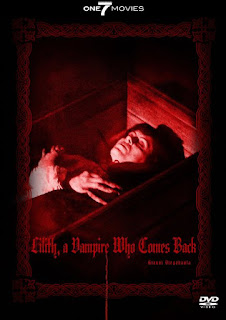Director: Amy Hesketh
Release date: 2015
Contains spoilers
One of the interesting things about this film is it is Bolivian in origin (though star/director/writer Amy Hesketh is, I believe, American). I ordered the DVD direct from
Vermeer Works as it was a touch cheaper than the Amazon US price (especially when shipping to the UK was taken into account) but was slightly disappointed that it arrived without packaging of any sort – not that this has affected the score or takes away from the film, and it will have saved on shipping I’m sure – but if you like DVD packaging you might want to take it into account.
The title might be familiar to you.
Olalla was a story by Robert Louis Stevenson, from 1887, and has been translated into film before as
Black Passage, an episode of the TV series Suspense. This was another reason to become excited about the film, as it isn’t an often shot story.
 |
| Olalla and her boyfriend |
The film begins with a couple, Olalla (Amy Hesketh) and her boyfriend (Pablo Paravicini) sat watching
Nosferatu. He begins to speak, mentioning aspects of the film, whilst she sits in silence. He notes this eventually and suggests that she has been silent through the film and seems fascinated by it. When Hutter cuts his finger on screen she climbs onto his lap and they kiss, he begins to carry her but she bites him, shocking him, and then viciously bites at his neck – spitting a plug of flesh away.
 |
| phone home |
The attack is visceral and violent. She coughs, almost choking on the blood that sprays copiously from the damaged artery and blood spills out across the floor. Her white dress becomes red stained and, as she stops, she appears scared and panicky. She picks up the phone receiver and dials. When it is answered she says “
It’s me” and “
I did something”. She arrives bloodstained in her family home. Her sister, Ofelia (Mila Joya), slaps her and then warns that they have a guest, Nathan (Luis Almanza). We should stop a second and look at the family.
 |
| the family home |
Living in the house with Ofelia are a collection of uncles and an aunt. We have Aunt Aurora (Maria Esther Arteaga), Uncle Bruno (Erik Antoine) and the “twins” Uncle Edgar (Roberto Lopez) and Uncle Aurelio (Fermin Nuñez). Nathan is there recovering – from PTSD one would guess, the film is not explicit but he was a photo journalist covering war stories – and is unaware of the family’s nature. It is clear that Nathan is due to be on the family’s menu, at some point. Ofelia calls their Uncle Felipe (Jac Avila), the family patriarch, to come and deal with Olalla.
 |
| the priest and Roberto |
The film then tracks two parallel stories. The modern one with Olalla and the story of her mother, also called Olalla (and also played by Hesketh). In the historical story – set one would guess around the time of Stevenson’s story – a young man, Roberto (Christian Del Rio), is sent by his doctor to stay with a family. The local priest (Rhobess Pierre) warns him generally to keep a distance from Olalla. The family consists of her, her brother Felipe (played young by Alejandro Loayza) and her two children Olalla (played young by Valeria Huanca) and Ofelia (played young by Rosario Huanca).
 |
| Felipe arrives |
In the modern day we see that Felipe has aged but not dramatically so (given the time that must have lapsed) and that the two young girls have only aged as far as being young women. The story follows parallel tracks with the mother and Roberto being attracted to each other and her daughter and Nathan suffering the same attraction. When Felipe arrives at the family house Ofelia’s first reaction is to kiss him deeply – we thus get an understanding that the family is incestuous. His method of re-educating Olalla – so her actions don’t draw attention to the family – is to keep her bound, whip and rape her.
 |
| a wee dram of blood |
The vampiric lore is sparse. They are clearly long lived, blood drinkers (though such drinking doesn’t seem to need to be as often as many vampire films portray). They can certainly be in sunlight, and they both photograph and cast reflections. The vampires seem to be born as such, and Olalla and Ofelia are looked on to carry on the family line. It would seem they can die through methods that would kill any mortal. In Black Passage the children did not drink blood, something that only began in adulthood. In this we see the aftermath of the child Olalla (younger, clearly, than Ofelia) drinking the blood of a dove, in other words we see a dead bird and blood at her mouth. This went to underscore the fact that, even as a child, Olalla had self-control issues.
 |
| the 'twins' |
The film is in Spanish with some English – Olalla and Bruno both speak in English (Olalla preferring to communicate to Nathan in that language) and we do hear that she and Bruno had spent time with another part of the family in the North (presumably the US). And this brings me to one of my frustrations with the film. There was a huge amount of expansion that could have been drawn around the family, we get to see Felipe and Ofelia’s sexual proclivities and we know that Bruno likes to bake but little else. I called the two uncles twins because they dress the same, groom the same and move the same – but we find no more out about them. Aurora seems to be a matriarch – but again the film is frustratingly silent. This sits with the fact that the two stories were actually fairly simple and a deeper exploration of some of the side characters would have off-set this. I found the climax of the 19th century section was perhaps a tad drawn out and could have been edited down.
 |
| attack |
There were some technical issues as well. There seemed to be a degree of wobble on depth of focus, mainly on outdoor shots. There was also a point where a scene got a little choppy film wise as the dialogue continued – but that might have been a dvd issue. On the other hand I was rather taken with the very Spanish soundtrack, which suited the film very well indeed.
 |
| young Olalla post dove |
The technical issues I have mentioned were not enough, I do have to say, to lower the score and the simplicity of the stories was offset by the atmosphere. I was reminded a little of
La Maison Nucingen, this probably was down to the eerie family members as much as anything and, for some reason, the film brought
Tremendo Amanecer to mind also. The pace of the film was languid at times but it suited that pace and the atmosphere of the house, which seemed out of kilter time-wise, with only Nathan's tablet (and the contents of Olalla's flat) betraying the true date of the modern setting.
I have been a little torn, score wise. I settled on
7 out of 10 but with a caveat that it nearly dipped just a little lower. However there is a style to this and with some further characterisation it could have built itself to being a classic. As well as Amazon and Vemeer Works the film is available on demand at
Vimeo.
The imdb page is
here.







































































